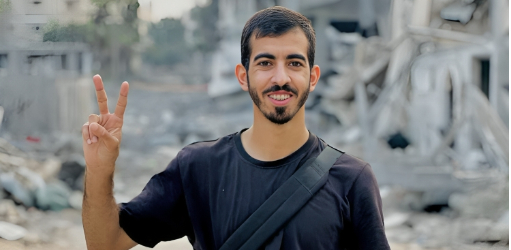This is a notification message.

A report by "Euronews" titled "Working on the Edge of Death" stated that with the Israeli army resuming its military operations in Gaza, the targeting of Palestinian journalists and correspondents has returned. Two reporters were killed in the northern and southern parts of the Strip, bringing the total number of journalist casualties to 211. The total number of people killed by Israeli army fire has exceeded 50,000, while the number of wounded has reached approximately 113,000, according to official sources.
The report emphasized the increasing dangers facing journalists in Gaza, noting that within one hour, two Palestinian journalists were killed by Israeli army fire. The first, Mohammed Mansour, a correspondent for Palestine Today, was killed when an airstrike hit a house in the Al-Batn Al-Samin area, west of Khan Yunis, southern Gaza. The second journalist, Hussam Shabat, a correspondent for Al Jazeera, was killed when an Israeli airstrike targeted his car on Salah al-Din Street, northern Gaza.
Helmets and Vests
The report pointed out that journalists in Gaza have returned to wearing bulletproof vests and helmets, after temporarily setting them aside during the fragile ceasefire. It also noted that since 2007, Israeli authorities have prevented the entry of safety equipment for journalists.
According to Reporters Without Borders, Israel continues to ban foreign journalists from entering Gaza to cover the ongoing military and humanitarian crisis. Additionally, Palestinian journalists in exile are prevented from returning to the Strip.
The organization reports that at least 180 journalists have been killed by the Israeli army over the past 15 months of war, with at least 42 of them killed while on duty.
The Risk of Death
Journalist Youssef Faris, who has worked as a correspondent in Gaza for over 15 years, told Euronews that the situation for journalists is "extremely dangerous". He explained how field reporters and prominent journalists have been directly threatened by the Israeli army, which accuses them of being affiliated with armed factions rather than legitimate journalists.
Meanwhile, indirect threats come in the form of incitement against them by Israelis in Telegram groups, where some members call for their assassination.
According to the Euronews report, journalists in Gaza can be categorized into three groups:
Those who continue working despite the dangers, fully aware of the risks.
Those who have stopped working due to the severity of the situation.
Those who have left Gaza altogether.
Journalists in Gaza say their movements have been severely restricted for over a year. Due to the bombing, they are unable to operate freely in the field. Moreover, collaboration with civil defense and ambulance teams has ceased after humanitarian workers were targeted and bombed for assisting journalists, according to Faris.
Logistical Struggles
Journalists in Gaza face an ongoing crisis due to severe communication and internet disruptions. At times, they are forced to walk long distances under bombardment just to verify a piece of information before publishing it, when the network allows.
Additionally, correspondents struggle with weak internet connections, which makes uploading even small files extremely time-consuming. However, this is a minor concern compared to the risk of death, as many journalists have been killed inside their own homes, which were bombed.
The Most Dangerous Place
A report by the International Federation of Journalists described 2024 as an "exceptionally deadly year", with 104 journalists killed worldwide. More than half of these deaths occurred in Gaza and Lebanon since October 7, 2023.
In May 2024, UNESCO awarded its annual "Guillermo Cano Press Freedom Prize" to Palestinian journalists covering Gaza, based on a recommendation from an international jury.
Reports from human rights and press organizations continue to highlight the dire conditions of journalists in Gaza due to the ongoing war. Various organizations have labeled the Strip as "the deadliest place for journalists on Earth."
Other groups have gone even further, describing Gaza as "the most dangerous region in the history of journalism."
This explains why journalists continue to be killed by Israeli forces, turning them into victims of the very tragedies they are trying to report to the world.

تستقبل نساء غزة يوم الأم...

تواصل الآلة الإعلامية الإسرائيلية حربها...